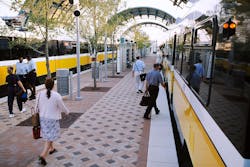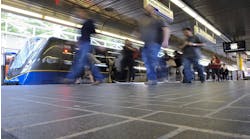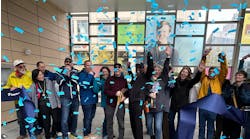In a region known for its reliance on automobiles, Dallas Area Rapid Transit (DART) has implemented one of the largest and fastest-growing public transit systems in the country. Combining vision and prudence, the agency has built a network of bus, light rail and commuter rail services encompassing 13 cities during the past four decades. With Dallas-Fort Worth growing exponentially, DART leaders identified a series of capital projects to improve the agency’s ability to move more trains and people – especially in downtown Dallas where all four light-rail lines converge.
One of the capital projects is the extension and modification of the platforms at DART’s Red and Blue Line stations. Currently, the Red and Blue lines are limited to two-car trains due to platform lengths at 21 of 28 existing stations. These stops were built prior to 2004. All other stops were either built with three-car trains in mind or have already been updated. By expanding the platforms at these stations, three-car trains can be operated system-wide.
At the seven remaining stations, which were originally constructed to accommodate the additional car, a third special use raised platform area will be built per American with Disability Act (ADA) standards. The existing special use raised platform areas will be relocated to allow for level boarding. Construction of the $128-million project, which is funded through a combination of federal grants, state grants and local transit sales taxes, began in summer 2019. DART estimates that when the project is completed in 2022, capacity on the light-rail system will increase by 33 percent.
“As our regular DART riders know, the platforms and trains on our Red and Blue light-rail lines can fill up very quickly, especially during peak travel times,” said John Rhone, DART vice president of capital design and construction. “Through our platform extension project, we can provide our riders with greater capacity and comfort, ensuring all North Texas residents have access to the mobility opportunities they need to get to jobs, school and health care.”
CM/GC delivery
Given the scale and complexity of the project, DART wanted to reduce passenger inconvenience, impacts to current operations, project costs and delivery time. To accomplish these objectives, the agency chose the Construction Manager/General Contractor (CM/GC) procurement method. The project was programmed into five groups for design and construction. Each group was responsible for a line section and comprised its own Final Engineering Consultant (FEC) design team for the design phase and a CM/GC team for the construction phase. The five groups included:
Lockwood, Andrews & Newnam, Inc. (LAN) is providing project management services and L.H.F., Inc. is providing scheduling services. By using the CM/GC delivery method, DART has reaped numerous benefits to-date.
Continuation of Service
With so many stations under construction at the same time, one of DART’s priorities was to continue passenger service with minimum impacts. To this end, the agency retained a third-party consultant to model the system and determine the operational impacts of the project on revenue operations and train schedules. The existing computer model of the DART system was updated with the planned improvements and analyzed. The model was run with a various number of stations under construction to generate baseline delays. The results indicated that no more than six stations should be constructed simultaneously. Based on this model, DART presented the construction sequence to the CM/GC groups. This helped the groups to be aware of their own schedules, as well as those of the other groups. DART also gave the CM/GC teams the leeway to determine a different sequence within their group if it did not negatively impact other groups’ schedules or overall operational service.
The project teams were also nimble to react to unforeseen circumstances. A case in point: Due to the government shutdown between December 2018 and January 2019, the review of the project’s Full Funding Grant Agreement was delayed. As a result, DART submitted a Letter of No Prejudice to begin construction activities on the Red Line North section. In February 2019, the Letter of No Prejudice was granted with construction to begin in March 2019. A full re-sequence of all stations was performed while maintaining the original finish date of the project.
During construction, the CM/GC teams also used a phased construction approach to ensure continuous service and maintain normal operations. For example, in Groups D and E, DART and Philips May Corporation used a five-phased approach for most stations. The extensions were installed first before the existing platform elevations were reworked. The extension areas served as additional platform length where the trains could operate a single car on the weekends and the contractor could rework the adjacent platform in a continuous 52-hour period of work. This facilitated the proper berthing of the standard two-car train first thing on Monday morning.
Cost Savings
During the preconstruction phase of the project, the CM/GC teams provided constructability reviews to determine more efficient ways to build the project. Originally, at the 30 percent conceptual design phase, the stations were extended by the full length of a new car or 120 feet. Due to impacts on existing train system elements, the initial pricing was significantly over budget according to Federal Transit Administration and DART standards. Subsequently, DART, the design teams and the CM/GC teams performed a value engineering analysis to refine the project scope and identify cost savings.
This collaboration resulted in a solution that modified the existing layout of the station platforms and extended each station approximately 60 feet on average. The reduced extension lengths helped avoid modifications to expensive communication and signal system elements. Following the analysis, DART also decided to self-perform some of the work, thereby avoiding unnecessary contractor costs. This preconstruction approach and collaborative efforts amongst all parties helped bring the project within budget.
“Preconstruction efforts should not be minimized,” said Jered Brookshear, project manager at Philips May Corporation. “It is probably the most important part of the CM/GC delivery method. The money spent during preconstruction can be recuperated, if not exceeded, due to savings from value engineering. Doing research, planning, scheduling, phasing, procurement, subcontract agreements and submittals during preconstruction helps mitigate risks and ensures that quality construction work is performed safely, on time, and within budget.”
Better Collaboration
The CM/GC method facilitated improved collaboration between various parties by engaging them early on, all working toward the same goal. Officing out of DART’s facilities, the design and CM/GC teams collaborated within their group and among the other four groups. Meetings between the prime contractor and lead design teams were conducted by the prime contractor’s project managers. This approach helped the project managers to offer their ideas for the design teams to consider. The prime contractor was also able to instantly hear feedback from the design teams. DART also provided input and guidance along the way. As a result of this collaboration, which lasted nine months, the project teams came up with creative cost and time-saving solutions.
For example, the typical DART station is constructed with a grade beam under the front faces of the stations. Since DART required the stations to remain open during construction, the prime contractors provided input on achievable excavation depths and the necessary horizontal distance away from active rails so that structural foundations could be properly designed with constructability in mind. The solution was to use cantilevered precast panels on most stations. These cantilevered precast panels provided the necessary station profile, while eliminating the need to excavate so close to the active transit rails.
While the overall approach was to provide global solutions wherever possible, each station was also looked at individually. For instance, one side of White Rock Station on the Blue Line has a tall Mechanically Stabilized Earth (MSE) wall with straps a couple of feet within the station extension footprint. The prime contractor and designer evaluated the deep MSE wall rock infill and determined that a slab on grade would suffice due to lack of sub-grade soil swelling in the vertical direction. By eliminating the need to remove the MSE wall, the project team removed a major traffic impact to the city.
Expedited Construction Mobilization
The CM/GC delivery method allowed the contractors to start planning their work early. Typically, in a traditional design-bid-build, the contractor doesn’t see the plans until the bidding stage and must come up with a construction plan in a short time frame. In this project, because the contractors were involved in the design stage, they were able to have early discussions with suppliers, subcontractors, subconsultants and the entire project team to mobilize resources more efficiently. It also helped ensure proper outreach to Disadvantaged Business Enterprises to achieve participation goals.
At Morrell Station on the Blue Line, DART negotiated a temporary construction easement with Oncor Electric Delivery Company before construction commenced. The contractor provided input to DART on how large the temporary easement needed to be to construct the northbound platform extension. Similarly, the VA Medical Center Station lacked DART property that could be used as a viable construction laydown area during construction. The CM/GC delivery method allowed the prime contractor to select a preferred area adjacent to the platform extension and establish an agreement between the city of Dallas and DART before construction started.
Also, station amenities typically have long lead times. The prime contractors worked with the designers and suppliers to ensure that DART received the closest Buy America match and confirm lead times earlier in the project. Likewise, Glass Fiber Reinforced Concrete (GFRC) warning strips are critical to this project. There is only one certified company in the country that manufactures warning strips matching the existing ones. To avoid potential delays that could result from backlogs, Philips May Corporation placed the order for 1000 GFRC warning panels 10 months in advance.
Project Now on Track and Under Budget
Thanks to these creative solutions that resulted from the CM/GC delivery method, the project is on track to be completed on schedule and under budget. Construction will be completed in August 2021. Testing will commence in September 2021 and three car revenue service is anticipated to begin in February 2022.
-----------------
Sofia M. Ojeda, P.E.,PMP, CMQ-OE, is a senior associate at Lockwood, Andrews & Newnam, Inc. (LAN), a planning, engineering and program management firm. She is serving as the senior project manager for this project. She can be reached at [email protected].



